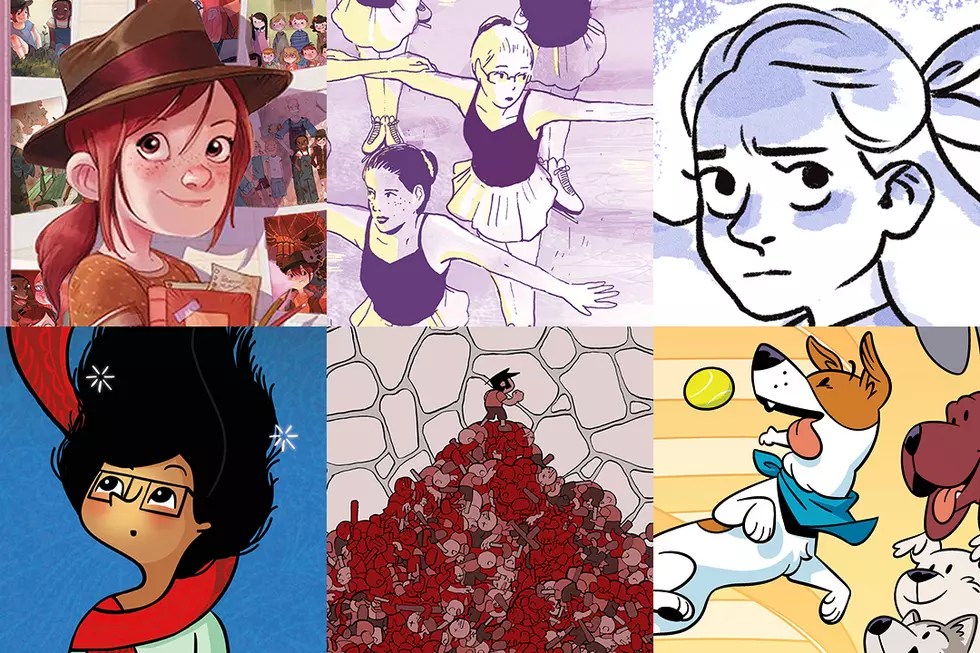![Maris Wicks Leads You Into The ‘Human Body Theater’ [Interview]](http://townsquare.media/site/622/files/2014/10/HBT_085_COLOR_SAMPLE-455x630.jpg?w=980&q=75)
Maris Wicks Leads You Into The ‘Human Body Theater’ [Interview]
First Second is that rare thing in comics: a savvy publisher that is incredibly on the ball with future releases, announcing books up to two years in advance, and getting people excited about titles via promotion that's thorough, yet not in-your-face and bothersome. In that vein, I'm happy to share another of their upcoming books for 2015; Human Body Theater, a non-fiction biology guide by Maris Wicks (Primates), in which she acts as a master of ceremonies, leading readers through a theatrical revue of each and every biological system of the human body.
Starting out as a skeleton, the MC in Human Body Theater puts on a new layer of her costume (her body) with each "act." Wicks has long been passionate about science, having worked as as a science educator for elementary and middle-school students; a fact that's clearly evident when she talks about the book and its subject in our chat below -- and now that interest has combined with her artistic credentials to create this comics-format tour of the human body.
ComicsAlliance: You're a biology/science educator. Can you tell us a bit more about that, and the capacity you work in?
Maris Wicks: I've been a program educator for the New England Aquarium for the past seven years. My job is mostly outreach, taking live tide pool animals -- sea stars, hermit crabs, horseshoe crabs, snails, clams, oysters, etc. -- to classrooms all over New England. I also teach afterschool classes, as well as work in the main building of the Aquarium -- think of it like a museum docent, but for tanks of live animals instead of paintings.
Sometimes I even get to dress up as a giant penguin. It's... a pretty awesome job. I have always maintained a full or part-time job that is outside the scope of art/comics; a) because I needed to financially, and b) because I love teaching.

CA: Did you study a science at college? Where does your passion and interest for the subject stem from?
MW: Ha! I actually went to school for art! I graduated from the Rhode Island School of Design, aka RISD, with a BFA in Illustration in 2003.
It was a difficult decision to choose a school with little to offer in the way of hard science -- I was a pretty big bio-chem nerd in high school -- but I found inspiration in the nooks and crannies. RISD has an incredible collection of specimens -- taxidermied animals, skeletons, rocks, minerals, even prepared microscope slides -- in an area called the Nature Lab. There were multiple classes on science theory and history.
And, despite my insane school workload and summer job, I found the time to become EMT trained and certified in 2002. I was considering that as a career post-college, but hey, that's a comic for another day.
By the end of college, my scientific focus had shifted to human anatomy and physiology, ecology and environmental education. Ultimately, RISD was the right choice; I was privileged enough to study under the tutelage of David Mazzacchelli -- that class pretty much set me on the comics course that I'm currently on today -- and be studio-mates with Joe Quinones, Paolo Rivera, R. Kikuo Johnson, Katherine Roy, and a whole bunch of other comics-minded people.
CA: There are quite a few illustrated biology and science books and guides. In what ways is this one different?
MW: Certainly! Many of the books already out there were an inspiration to me -- any of the DK Eyewitness Books, David Macaulay's The Way We Work, even the Magic School Bus: Inside the Human Body. I wanted to make a book that I was passionate about, but do it my way: with jokes, visual gags, and the awesome narrative that is the heartbeat of comics.
Framing complex and somewhat difficult to digest (pun: intended) information is my favorite part of not only comic-making, but also my education career. How do you get someone interested in digestion? Sea slugs? Nuclear fusion? Orangutans? Slime molds? The airspeed velocity of an unladen swallow? For me, it's the same recipe in comics as it is in education: passion, enthusiasm, and little humor. We are not born without curiosity; it is in our nature to discover, to learn, and to share. I want to share what I love with lots and lots of people.
CA: How did you keep a balance between creating something that is informative and educational, yet engaging and appealing at the same time?
MW: Hmmm. Self-editing definitely plays a role, and having a target audience to consider is helpful -- in this case, roughly 9-13 year-olds -- but certainly not limited to that age range. The first step is narrative: we are a species that thrives on stories -- fiction or non.
Then comes content: with Human Body Theater, the content already exists; I'm not making any new discoveries. But I am framing this content in a way that has maybe never been done before, and I'm hoping the way that I do this resonates with readers. I mean, how can you not be a little curious about a chorus line of smiling dismembered body parts, led by skeleton?
The other side to this answer is feedback; I am incredibly grateful for my friends, colleagues and editor -- Calista Brill at First Second -- who have helped me to make this book the best that it can be. And First Second Books, for giving me a nerdy soapbox to stand upon and sing my praises of science!
Human Body Theatre will be published in October 2015.
More From ComicsAlliance







![Batgirl #35: Making Out, Dressing Up, And Defeating The Forces Of Misogyny [Review]](http://townsquare.media/site/622/files/2014/10/Untitled-22.jpg?w=980&q=75)
![Celebrating ‘Tintin’ On Creator Hergé’s 107th Birthday! [Art]](http://townsquare.media/site/622/files/2014/05/herge_bday_FLAT.jpg?w=980&q=75)
